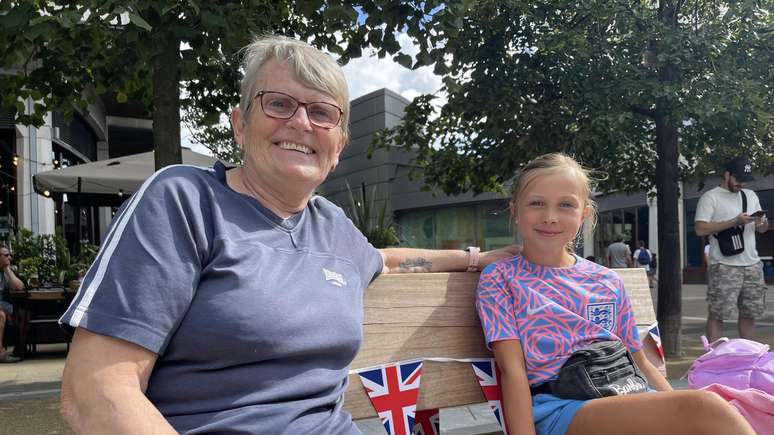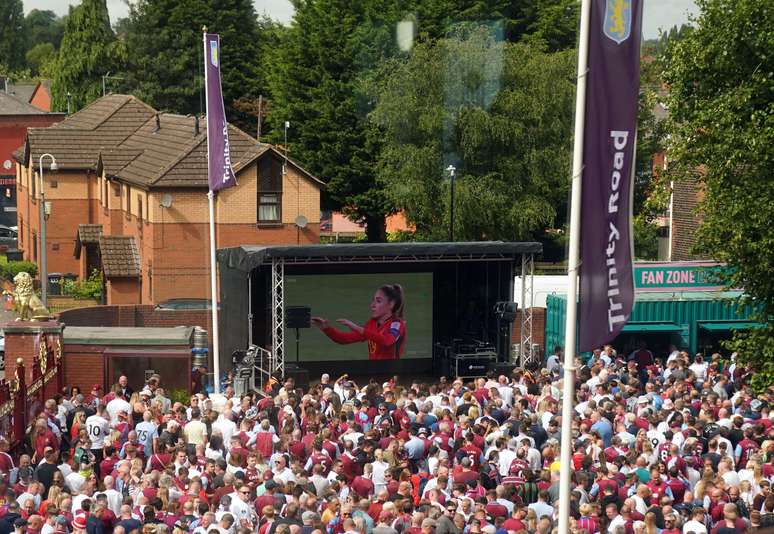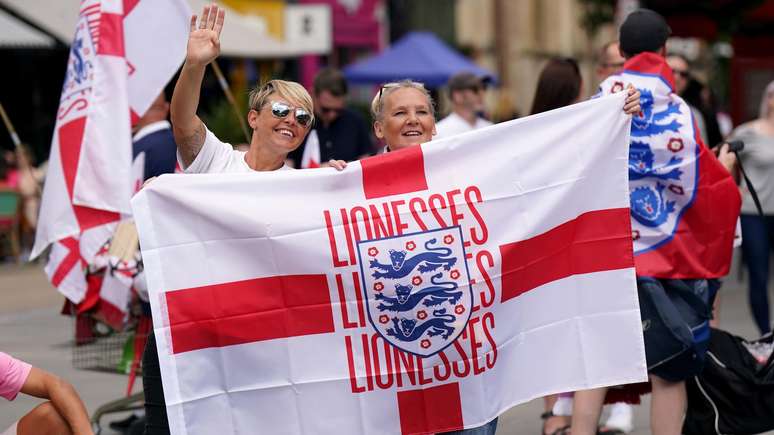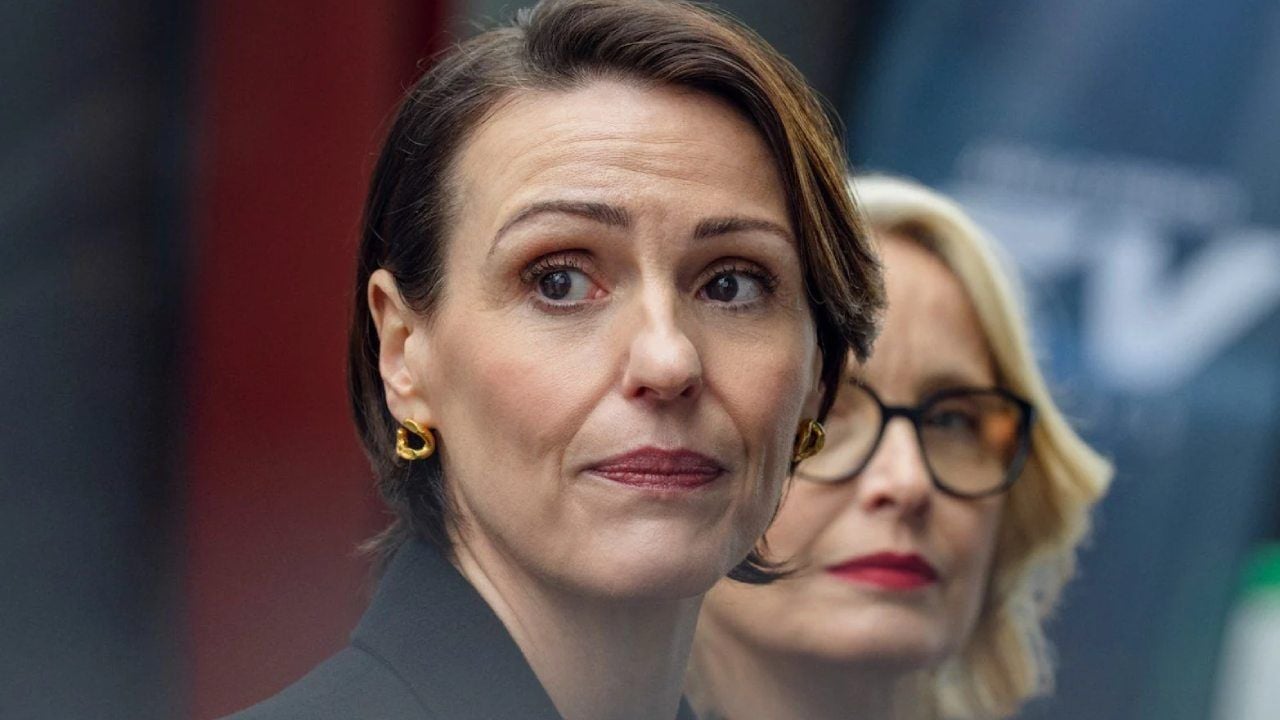Increased investment in the domestic league and an increase in the quality and quantity of news coverage of women’s football have been key to the growth of the England squad, says an expert.
At the age of 8, England’s Kitty Lawrence already understands what it’s like to see her country’s women’s team in a World Cup final.
“I’m impressed,” she told BBC News Brasil. “Some women in England can’t follow their dreams, but now we can play football. I’m very proud and satisfied.”
Dressed in the women’s national team kit, Kitty and her family watched the decision against Spain on a screen set up in a London square. Even with the 1-0 defeat, the grandmother, Pauline Lawrence, celebrated.
“I played football as a child but was never able to make any progress in the sport,” he said.
It wasn’t for lack of will. Up until a few decades ago, women couldn’t even play professionally.
Now, the Lionesses – nickname of the women’s team – are adored by the British, inspiration for girls, synonymous with success.
Despite the defeat in the final, the English team’s good campaign has inspired the country and given new impetus to English women’s football.
To get here, however, the specialists underline that a greater investment in the national championship and a qualitative and quantitative increase in the journalistic coverage of women’s football were fundamental. So, understand this trajectory.

From ban to world power
In 1921 there were about 150 women’s soccer teams in the country. The future was promising. But the English Football Association decided to ban the practice on professional fields and clubs affiliated with the body, deeming the sport was “not suitable for women”.
The ban was only lifted in 1970, and there was more than 40 years of waiting until the moment considered the tipping point, and that has to do with Brazil.
At the 2012 London Olympics, Great Britain played team Brazil in front of 70,000 people at Wembley Stadium. With the stands packed and the crowd available, the potential of women’s football became clear.

The Women’s Super League (WSL), the new format of the English women’s first division, had just begun. And, in this context, sponsorships and professionalization have arrived.
Furthermore, for Professor Stacey Pope, a specialist in women, sport and inequality at the University of Durham, England, and author of the book The Feminization of Sports Fandom (The Feminization of Sports Fans, in free translation), the growing interest in the press after the 2015 World Cup was fundamental.
“Before 2015, there was virtually no coverage in traditional media,” he told BBC News Brasil.
“It was the first time all England matches were shown live on the BBC, the public television. It was crucial because it raised the profile of women’s sport. It’s very difficult for fans to follow and connect with a World Cup World from start to finish . without television coverage.”
Pope is one of the authors of a study published in the Sociology of Sports Journal which compared coverage of women’s football in five major British newspapers at the 2015 and 2019 World Cups.
In 2019, six times as many articles were published, and the use of words like “girls” — which research shows infantilize female gamers — dropped dramatically.
“Not only was there more coverage, but it was respectful, focusing on the technical side and team results rather than sexualizing players as we’ve seen too often in women’s sports,” Pope said.
“It has also coincided with other big changes. For example, the WSL went fully professional in 2018 and more opportunities for girls and women to play football. In a short period of time they have been phenomenal.”

Investments in the national championship were reflected in the national team and turned into titles with the signing of Sarina Wiegman.
The Dutch coach, European champion and World Cup finalist at the helm of her country, took over in 2021.
The following year, England won the European Cup by beating Germany at Wembley in front of over 87,000 people.
The WSL has grown into one of the strongest leagues in the world, bringing together stars like Australian Sam Kerr and England’s Lauren James, revealed by Arsenal in her teens. Both play for defending champions Chelsea.
But there was room to grow. With the success of the Euro, the English FA has set targets to increase television audiences and fans in stadiums. In September 2022, Arsenal x Tottenham gathered a league record attendance of 47,367. And other brands have been hit at clubs over the months.
In April this year, in the final leg of the run-up to the World Cup, more than 83,000 spectators watched England beat Brazil in London in the Grand Final, a match-up between the Copa América and Eurocopa champions.
Wiegman has built the England squad into a nearly unbeatable side – including in the World Cup final, they have lost just two games in 39.
Recent hindsight is better than that of English men. The men’s team was defeated in the Euro Cup final in 2021 and eliminated in the quarterfinals at last year’s World Cup. The only world title was in 1966.

Challenges
Looking to the future of women’s football in England, Pope points to the challenges.
“Many fans are frustrated with the punctuality of media coverage just for an important event like the World Cup. When it’s over, coverage of women’s football plummets,” she said.
“Also, there are inequalities globally. Professional players continue to work in a more precarious work environment, with lower wages, shorter contracts and fewer opportunities. They are still expected to choose motherhood or a career. One of the “My studies have shown that there is still hostility towards women’s participation in football. Sport is associated with masculinity and there is sexism and misogyny.”
After the Eurocup, the women’s team wrote an open letter to British Prime Minister Rishi Sunak – candidate at the time – demanding that girls and boys have equal access to the practice of football in schools.
Also in 2022, the British government commissioned an independent study to analyze the level of women’s football in the country. Published last month, it brought a series of recommendations, such as increasing professionalisation and creating a salary base for athletes.
According to Pope, the British experience could help Brazil, eliminated in the group stage of the Cup and looking for an unprecedented world title. There is a fundamental point: to spread women’s football in the country.
“Everyone should have equal access to sport. There is a lot to learn from countries like England and the United States in terms of the infrastructure that has been developed to help elite sport grow,” he said.
Twenty of England’s 23 players play in the domestic league. The WSL season starts in October. It will be the continuation of a growth cycle of more than ten years, without forgetting what needs to be improved.
Kitty and other children certainly have something to look up to.
Source: Terra
Rose James is a Gossipify movie and series reviewer known for her in-depth analysis and unique perspective on the latest releases. With a background in film studies, she provides engaging and informative reviews, and keeps readers up to date with industry trends and emerging talents.







